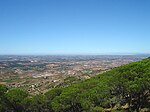Barreiras (Cadaval)
CadavalLisbon geography stubsVillages in Portugal
Barreiras is a small Portuguese village located in Peral, Cadaval, in the Lisbon district. Its population is around 110 inhabitants, all over the village, but its center has just around 60.
Excerpt from the Wikipedia article Barreiras (Cadaval) (License: CC BY-SA 3.0, Authors).Barreiras (Cadaval)
Cadaval
Geographical coordinates (GPS) Address Nearby Places Show on map
Geographical coordinates (GPS)
| Latitude | Longitude |
|---|---|
| N 39.2666 ° | E -9.0545 ° |
Address
2550-458 Cadaval
Portugal
Open on Google Maps




